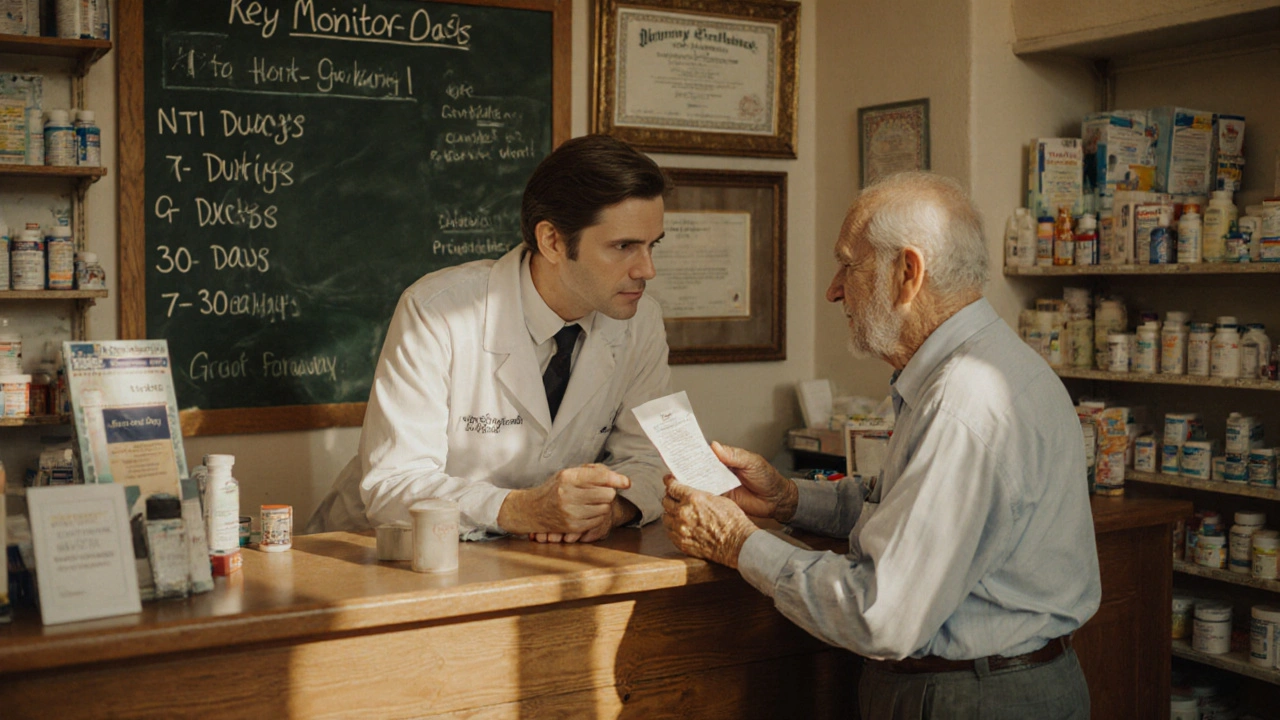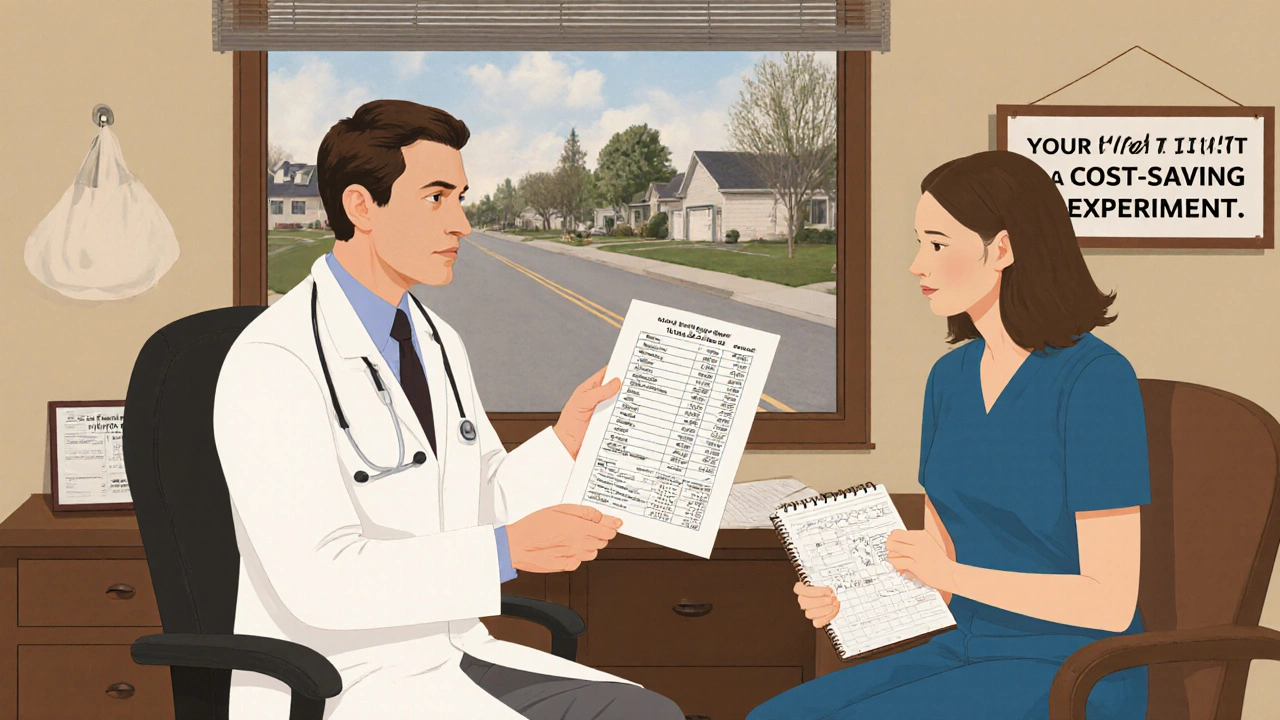How to Track Medication Effectiveness After a Generic Switch

Switching from a brand-name drug to a generic version is common-over 90% of prescriptions in the U.S. are now filled with generics. It saves money, and regulators say they’re the same. But if your blood pressure suddenly spikes, your seizures return, or you feel worse after the switch, you’re not imagining it. Sometimes, generics aren’t as interchangeable as they seem. Tracking effectiveness after a switch isn’t optional-it’s essential, especially for certain drugs.
Why Some Generics Don’t Work the Same Way
The FDA requires generics to be bioequivalent to the brand name. That means the amount of active drug in your bloodstream should fall within 80% to 125% of the brand’s levels. Sounds tight, right? But here’s the catch: that 45% range allows for big differences in how your body absorbs the medicine. For most drugs, like lisinopril for high blood pressure, it doesn’t matter. Your body adjusts fine. But for drugs with a narrow therapeutic index-where the difference between a helpful dose and a toxic one is tiny-those small changes can cause real problems.Think of it like this: warfarin (a blood thinner), levothyroxine (for thyroid), and epilepsy meds like phenytoin aren’t like ibuprofen. If your INR (a blood test for warfarin) jumps from 2.5 to 3.8 after a switch, you’re at risk of bleeding. If your TSH (thyroid hormone level) swings from 2.1 to 6.5 after switching levothyroxine, you’ll feel exhausted, gain weight, and risk heart issues. A 2018 study found that 23.4% of patients switched to generic levothyroxine had TSH levels outside the safe range within six months. Only 8.2% of those who stayed on the brand did.
What to Track: The Key Metrics
You can’t just wait and see if you feel better. You need to measure. Here’s what matters most:- Lab values: For warfarin, track INR weekly for the first month. For thyroid meds, check TSH at 6 weeks and again at 3 months. For epilepsy drugs, monitor drug levels if your doctor orders them.
- Symptoms: Did your seizures return? Are you dizzy, nauseous, or more anxious? Write these down. Don’t wait for your next appointment.
- Medication gaps: If you stop taking the drug for more than 90 days after the switch, that’s a red flag. Studies show this is one of the strongest indicators that the generic isn’t working-or you can’t tolerate it.
- Emergency visits: A 2016 FDA analysis found a 12.3% increase in ER visits for patients switched to generic epilepsy drugs. If you end up in the ER after a switch, ask: was this related to the medication change?
For high-risk drugs, your doctor should have a plan. At Kaiser Permanente, patients get automated calls at 7, 30, and 90 days after a switch. That’s not luck-it’s a system. If your clinic doesn’t do this, ask them to start.
Which Drugs Need the Most Attention
Not all generics are equal. Some categories have far more reported issues:- Antiepileptic drugs (AEDs): The American Academy of Neurology documented 14 cases where patients had breakthrough seizures after switching to generics. In 87% of those cases, seizures stopped when they went back to the brand.
- Thyroid meds (levothyroxine): As mentioned, over 1 in 4 patients had abnormal TSH levels after switching. Even small changes can affect mood, energy, and heart health.
- Warfarin: A 2021 study found 27.6% of patients needed a dose adjustment within 60 days after switching to generic warfarin. Only 12.3% of those on the brand did.
- Digoxin: A 2019 study showed a 34.7% increase in hospitalizations for digoxin toxicity after switching to generics.
- Psychiatric meds: Antidepressants and antipsychotics have more patient reports of side effects or loss of effectiveness. Reddit and patient forums are full of stories-83% of pharmacists say patients quit generics because they felt worse.
On the flip side, drugs like lisinopril, metformin, and atorvastatin show almost no difference in outcomes between brand and generic. The FDA gives most generics an “AB” rating-meaning they’re considered interchangeable. But watch out for “BX” ratings. Only 1.7% of generics get this, but they’re the ones you need to be extra careful with.

How to Set Up Your Own Tracking System
You don’t need fancy tech. Just structure your approach. Use this four-phase plan:- Before the switch: Write down your current lab results, symptoms, and medication dose. Take a photo of your pill bottle. Keep a copy of your prescription.
- Days 1-7: Talk to your pharmacist. Ask: “Is this the same as before?” and “What should I watch for?” Write down any new side effects immediately.
- Days 8-90: Follow a strict monitoring schedule. For NTI drugs: weekly labs, daily symptom journal. For others: monthly check-ins. Use a free app like Medisafe or even a notes app on your phone.
- Day 91+: If your numbers are stable and you feel the same, you can switch to routine monitoring. If not, go back to your doctor. Don’t wait.
Many clinics don’t do this automatically. So take charge. Print a simple chart: Date | Lab Value | Symptom (Yes/No) | Notes. Bring it to every appointment.
What Your Doctor and Pharmacist Should Be Doing
You shouldn’t have to do all the work. But right now, most don’t. Here’s what good care looks like:- Your doctor should approve any switch for NTI drugs-no automatic substitution.
- Your pharmacist should call you 7 days after the switch to ask how you’re feeling.
- Your EHR (electronic health record) should flag the switch and alert your doctor if lab values change by more than 15% in 90 days.
Only 38.7% of U.S. hospitals have automated alerts for risky switches. That’s not enough. If your doctor’s office doesn’t mention follow-up, ask: “Will you check my labs after the switch?” If they say no, get a second opinion.

When to Go Back to the Brand Name
If you’ve tracked your symptoms and labs and things are worse-don’t suffer. You have options:- Ask your doctor to write “Dispense as Written” or “Do Not Substitute” on the prescription.
- Check if your insurance covers the brand name with a prior authorization.
- Ask if there’s an authorized generic-this is made by the brand company and sold under a generic label. It’s the same pill, just cheaper.
Many patients who go back to the brand after a bad switch feel dramatically better. One woman on a patient forum said, “I went from having 3 seizures a week to none in 2 weeks after switching back.” That’s not placebo. That’s real.
The Bigger Picture: Why This Matters
Generics save billions. That’s good. But if patients stop taking meds because they feel worse, or end up in the hospital, costs go up. A 2022 study showed that 68.4% of independent pharmacists track outcomes, but only 32.7% have a standard process. That’s inconsistent care.Now, the FDA is stepping up. Starting in 2024, all new NTI generics must prove real-world effectiveness after approval. By 2025, patients will be able to report side effects directly through an FDA-certified app. That’s progress.
But until then, you’re your own best advocate. Don’t assume “generic = same.” Track your body. Document changes. Speak up. Your health isn’t a cost-saving experiment.
Are generic drugs always as effective as brand-name drugs?
For most medications, yes. But for drugs with a narrow therapeutic index-like warfarin, levothyroxine, or epilepsy meds-small differences in how the body absorbs the drug can lead to real problems. Studies show higher rates of lab value swings, hospitalizations, and treatment discontinuation after switching to generics in these cases.
How long should I wait before deciding if the generic is working?
For high-risk drugs, check lab values at 2-4 weeks. For symptoms, track daily for the first 30 days. If you’re not stable by 90 days, the switch likely isn’t working. Don’t wait longer than that before talking to your doctor.
Can I ask my pharmacist to give me the brand name instead?
Yes. Ask your doctor to write “Dispense as Written” or “Do Not Substitute” on your prescription. You can also ask if an authorized generic is available-it’s made by the brand company and is identical to the original.
What should I do if I feel worse after switching to a generic?
Don’t ignore it. Start tracking your symptoms and any lab results. Contact your doctor immediately. Bring your notes. If your labs are off or symptoms are worse, you may need to switch back. Many patients feel better after returning to the original medication.
Is it safe to switch back and forth between brand and generic?
Frequent switching can cause instability, especially for NTI drugs. Each switch introduces potential variability in absorption. Stick with one version unless there’s a clear reason to change-and always monitor closely after any switch.
Next Steps: What to Do Right Now
If you’ve recently switched to a generic:- Check your last lab results. Are they in range?
- Write down any new symptoms-even small ones.
- Call your pharmacy and ask: “Was this switch approved by my doctor?”
- Set a reminder for 7, 30, and 90 days from the switch date. On those days, check your symptoms and labs.
- If you’re on warfarin, levothyroxine, or an epilepsy drug, schedule a follow-up with your doctor before the 90-day mark.
Don’t wait for a problem to get worse. Track it now. Your body tells you when something’s off. Listen to it.